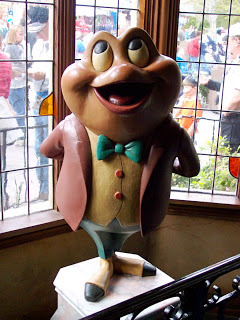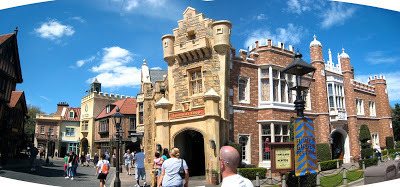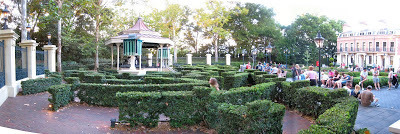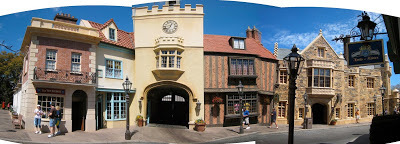Sam Gennawey's Blog, page 25
February 3, 2012
AWARD WINNERS CELEBRATED AT THE WALT DISNEY FAMILY MUSEUM
AWARD WINNERS CELEBRATED AT THE WALT DISNEY FAMILY MUSEUMSan Francisco, CA – January 31, 2012—February is awards season, and The Walt Disney Family Museum is celebrating with film presentations and visitor programs throughout the month.The San Francisco Bay Area is home to several Oscar® winners, including Pixar and Lucasfilm, but there is only one place where you can get an up-close look at more than 20 of the famous statuettes—The Walt Disney Family Museum. Walt Disney personally won 32 Academy Awards® throughout his career. To this day, Walt still holds the record for the most awards won by an individual. Former Oscar host Bob Hope once quipped, "The management has informed me that they're not responsible for Oscars left over 30 days. After that, they're automatically turned over to Walt Disney."Screening this month in the Museum's state-of-the-art digital theater is a collection of Walt's award-winning True-Life Adventures films. Produced between 1948 and 1960, these shorts and features won a cumulative 8 Academy Awards, and have inspired naturalist filmmakers and conservationists for decades (see below for a complete program). Among the films being screened in February will be the Best Documentary Feature winners The Vanishing Prairie (1954) and The Living Desert (1953); and the Best Short Subject winners Bear Country (1953), Water Birds (1952), Nature's Half Acre (1951), Beaver Valley (1950) and Seal Island (1948, the first film in the series). Admission to film presentations is free with paid Museum Admission.On Saturday, February 18 at 3:00 pm, the special program And the Award Goes to...Walt Disney offers a one-of-a-kind showcase of Walt Disney's Award Winners. Hosted by author, Disney historian and friend of the Museum Jeff Kurtti, this program offers a look at highlights of Walt Disney's Oscar-winning films, including rarities such as Parade of the Award Nominees (1932), Ferdinand the Bull (1938), and Grand Canyon (1958); as well as trailers and rare footage and photos of Walt at the Oscar ceremonies. (Separate admission required.)On Saturday, February 25 at 2:00 pm, the special program Walt Disney's Worlds of Nature will feature Academy Award-nominated producer Don Hahn (Beauty and the Beast, The Little Matchgirl) and a presentation about Walt's pioneering and frequently-emulated True-Life Adventures films, and showing the relationship between that series and the acclaimed Disneynature documentaries (Earth, Oceans, African Cats, and the upcoming Chimpanzees) for which Hahn serves as executive producer. (Separate admission required.)Tickets for all films and programs are available at the Member Services and Reception Desk at the Museum, or online at www.waltdisney.org. SCREENINGSFebruary 1 through 7 (Daily at 1:00 pm and 4:00 pm)Seal Island (27:00)Beaver Valley (32:00)Nature's Half Acre (33:00)February 8 through 14 (Daily at 1:00 pm and 4:00 pm)Water Birds (30:00) Vanishing Prairie (71:00)February 15 through 21 (except February 18) (Daily at 1:00 pm and 4:00 pm)Bear Country (33:00)The Living Desert (69:00)February 22 through 29 (except February 25 and 26) (Daily at 1:00 pm and 4:00 pm)Mysteries of the Deep (24:00)Secrets of Life (70:00)CLASSES + ACTIVITIESFriday, February 24; Saturday, February 25; and Sunday, February 26 Look Closer: Cameras used for the True-Life Adventures series1:00 pm and 3:00 pm Gallery 8 (Museum Admission Required)Take a more detailed look at the creation of the pioneering True-Life Adventures films, and the cameras used in their filming.Sunday, February 5Sunday Story Time3:00 pm – 3:45 pm Theater Lobby (Museum Admission Required) True stories unfold all around us! The stories this month will reflect the magic of the natural world and its inhabitants. This special program is designed for families with young children.Saturday, February 11 and Sunday, February 19Disney Discoveries!1:00 pm – 3:00 pmLearning Center Art Studio (Museum Admission Required) Are you going on a great adventure? Don't leave home without your very own adventurer's bag! Use it as a camera case, a collector of nature's treasures, or a tote for everyday travels! These fun totes will be made from recycled materials.LIVE PERFORMANCESaturday February 11A Musical Tribute to Walt Disney3:00 pmSpecial Exhibitions Hall (Separate Admission Required) Paulway Chew is a renowned vocalist with over ten years of musical theater experience. She performed with a Chinese Malaysian theater group in Kuala Lumpur and has received nominations for Best Supporting and Best Leading Role as a Female Performer. Now residing in San Francisco, Paulway is a huge Disney fan and a Founding Member of the Museum. Her performance combines a beautiful story, amazing vocals, and audience participation for Disney fans of all ages.# # #ABOUT THE MUSEUMThe Walt Disney Family Museum presents the fascinating story and achievements of Walt Disney, the man who raised animation to an art, transformed the film industry, tirelessly pursued innovation, and created a global and distinctively American legacy. Opened in October 2009, the 40,000 square foot facility features the newest technology and historic materials and artifacts to bring Disney's achievements to life, with interactive galleries that include early drawings and animation, movies, music, listening stations, a spectacular model of Disneyland and much more. Hours: 10 a.m. to 6 p.m., Wednesdays through Monday; closed on Tuesdays and the following public holidays: New Year's Day, Thanksgiving, and Christmas.Tickets: $20 adults, $15 seniors and students, and $12 children ages 6 to 17; Admission is free for members.Where: 104 Montgomery Street, The Presidio of San Francisco, San Francisco, CA 94129 415-345-6800Website: www.waltdisney.org www.facebook.com/thewaltdisneyfamilymuseum www.twitter.com/WDFMuseum
Published on February 03, 2012 04:30
February 2, 2012
When I first started writing about the Disney theme parks...
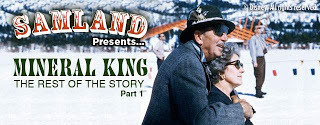
When I first started writing about the Disney theme parks I never expected that something like this would happen. On January 21, I was the host for a presentation and panel discussion at The Walt Disney Family Museum in San Francisco. The topic was the rise and fall of Walt's lost last project - the Mineral King ski resort to be located in the Sierra Nevada Mountains of California. My special guests were Ron Miller and David Price. Ron Miller, former CEO of Walt Disney Productions and one of the founders of the Museum, was in the room with Walt when decisions were being made and brought his firsthand knowledge and insights. David is the son of Harrison "Buzz" Price and a renowned architect of themed environments in his own right. David spent many days in the Mineral King valley when the project was under development and he brought his memories and professional insights into the discussion. The event was sold out.
READ THE REST AT MICECHAT
Published on February 02, 2012 01:30
February 1, 2012
BOOK EXCERPT

Over the next few months, AllEars.Net will be highlighting exclusive excerpts from Sam Gennawey's book, Walt and the Promise of Progress City. The book explores the process through which meaningful and functional spaces were created by Walt Disney and his artists, as well as how guests understand and experience those spaces. It also takes a look how Walt wanted to change the public's expectations about city life in the same way his earlier work had redefined what it meant to watch an animated film or visit an amusement park. In this month's excerpt, we learn about how the theme parks are spatially organized, and how the familiar "hub-and-spoke" layout came about.
READ MORE HERE AT AllEars.net
Published on February 01, 2012 02:30
January 31, 2012
MY HERO
Published on January 31, 2012 04:30
January 30, 2012
Chutes Amusement Park
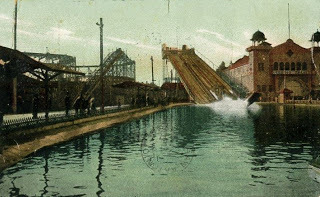
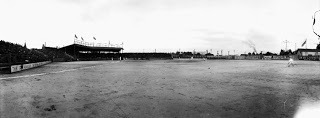
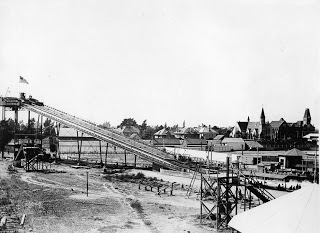
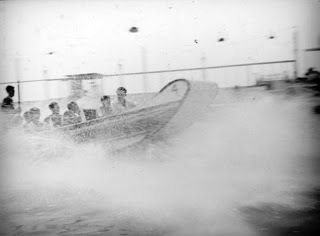
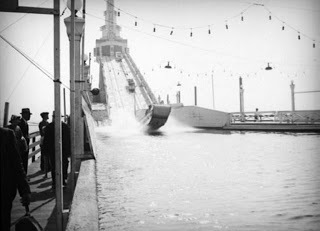
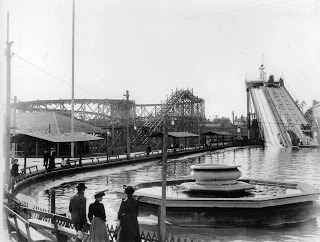
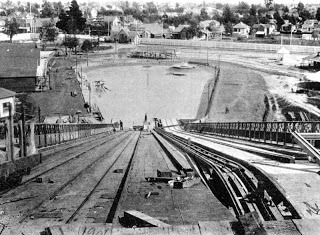
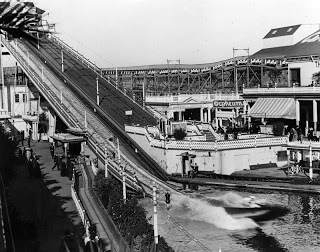
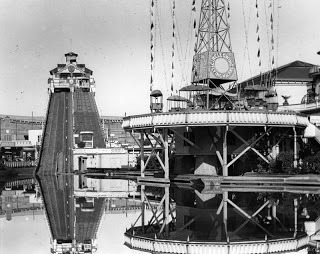
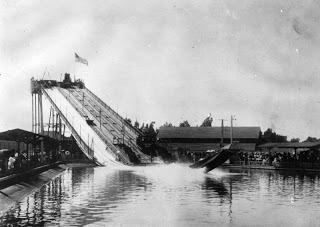
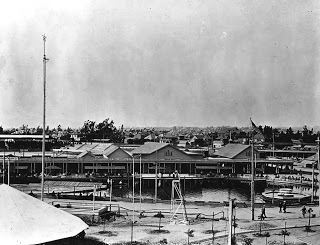
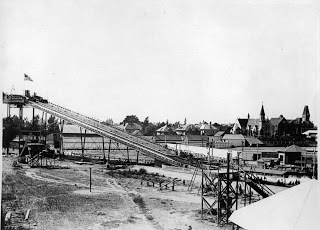
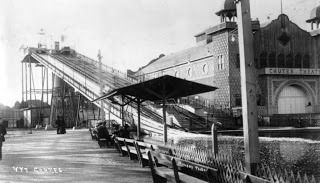
While doing research for Walt and the Promise of Progress City I was struck at the amount of empirical data that Walt and his team collected as part of the creative process. Walt and his team spent a lot of time in the field studying how others did business. From the book:
"Once Walt became focused on building an amusement park, he began to study everything he could about the subject. He visited dozens of parks to see what worked and what did not. On one trip with Art Linkletter, they visited Tivoli Gardens, built in 1843 in Copenhagen, Denmark. Linkletter said, "As we walked through it, I had my first experience of Walt Disney 's childlike delight in the enjoyment of seeing families and in the cleanliness and the orderliness of everything. He was making notes all the time about the lights, the chairs, the seats, and the food." Linkletter asked Walt what he was doing and Walt replied, "I'm just making notes about something that I've always dreamed of, a great, great playground for the children and the families of America." Walt liked how Tivoli Gardens was kept clean, was decoratively lit with popcorn lights outlining the buildings, and had outdoor entertainment. It was a park for both adults and children."
It was not uncommon for Walt to be found hanging out at some of the local amusement parks. He would spend hours observing how the children interacted with the activities.
"In doing his research he often visited the Bradley and Kay amusement center at La Cienega and Beverly boulevards in Los Angeles. During his frequent visits, he observed how the children used the facility. He knew the owners, Dave and Bernice Bradley, and was constantly quizzing them about their operations. He wanted to know how the rides worked, what people ate, and how people lined up in the queues. Bernice Bradley remembers, "Our park was very tiny. There was a carousel, a little train ride, and another little boat ride for children...Walt was out there almost every day, sitting on the end of the bench, watching how children enjoyed the rides." She added, "He also talked to a lot of the children, which is what he enjoyed the most. He challenged them. 'How was that horse you were riding? What color was it painted? Did you like it?'" Another nearby park where he could often be found was Beverly Park in Beverly Hills also owned by the Bradleys. Walt also visited Coney Island, Knott's Berry Farm, Travel Town in Griffith Park, the Los Angeles County Fair, and Oakland's Fairyland. His team studied fairs, zoos, and even Forest Lawn Memorial Park cemetery in Glendale-at the time the most popular tourist attraction in the Los Angeles region before Disneyland was opened."
This week I would like to revisit one of those great, lost Los Angeles theme parks that predated Disneyland. These parks inspired Walt Disney. He knew he could do it better. With the help of noted amusement park historian Richard Harris, this is the story of one such park. We are about to visit Chutes Park.
According to Richard, more than 65 years before Walt Disney would build Disneyland in Anaheim, Downtown Los Angeles would be the site of its first major 35-acre amusement park. At the height of its popularity, Chutes Park would feature attractions such as a roller coaster, a water slide, a large manmade lake, and a small miniature railroad.
Let's let Richard take it from here.
Chutes Park started off as a trolley park. Trolley Parks started in the 19th century along or at the end of their streetcar lines in some of the larger cities. The streetcar companies created trolley parks to give people a reason to use their transit systems on the weekends. They usually consisted of a picnic and recreation area and would feature events such as dances, concerts and shows. Some parks also had swimming pools, carousels, Ferris wheels, roller coasters, sports fields and boat rides. The parks were the precursors to amusement parks as we know of them today.
One of those companies was the Los Angeles Improvement Company who owned the Second Street Cable Rail Road Company that consisted of 1.6 miles of road. In December 1899, acquired the old Washington Gardens site at Main and Washington Streets near downtown Los Angeles and in August 1900 they unveiled plans to create an amusement park on 12 to14 acres. A Los Angeles Times article, reported that the new Washington Gardens would offer fun galore.
The highlight of the plan was to be Paul Boynton's Shoot the Chutes Ride, named for an inventor and world-renowned diver who had built similar attractions on the East Coast. Boynton's toboggan-like boats began their ride from a 75-foot tower and had descended down a 300-foot greased wooden ramp skipping across a lake at the bottom. An on-board ride attendant then pulled the boat back to the ramp.
J.P. Newberg built the first of this type of amusement ride in 1884 down the side of a hill at Watchtower Park in Rock Island, Illinois. This ride was copied over and over and "Chutes" rides were to be found at many amusement parks throughout America, and even became the name of several amusement parks in the United States. While the original form of the ride is largely obsolete, modern log flume rides like Splash Mountain work on similar principles.
Some of the other attractions in this amusement park were to include a Merry-go-round, Shooting Gallery, Bowling Alley, and a Japanese village and tea house. There would also be a kids playground with pony rides and goat carts, a zoological building, a 4,000-seat modern theater for vaudeville plus fields for baseball and football.
The Chutes Theater was among the first of the new attractions to open when it was used for vaudeville shows by December 1900. The following summer, a fishing pond, a small circus, daily hot-air balloon rides, the Catalina Marine Band and a small railroad that followed the outer perimeter of the park, joined the rides and theaters. A newspaper article from September 1901 said 7,000 people had visited the park on Labor Day.
The facility was state-of-the-art for its time period; its merry-go-round was electric powered at a time when most competitors were still using horse drawn equipment. The engine that pulled the boats back up from the lake to the tower was electric.
The name Chutes Park was applied to the baseball park, which opened around 1901, and was the original home of the Los Angeles Angels of the Pacific Coast League as well as the Vernon Tigers. After the ball games, a gate in the center field fence was opened and the fans were to be allowed to enter the theme park.
By October of 1903, the operators of the park had announced they would spend up to $40,000 to build a steel-framed figure-eight roller coaster. It would replace the hot-air balloon rides on the south side of the park near Main Street and Washington Boulevard. Within three years, the roller coaster and the water slide were in place.
By 1907, the park basically had the look it would carry until its end. Within the 10-foot wooden fence that surrounded the park were the major rides, animal pens, including a seal pond; the two-story Chutes Restaurant; a cigar store; a dancing school and skating park; a billiards hall; and a photo studio. There were other features like Tony Ryder's Monkey Circus. One of his animals was half chimpanzee and half orangutan, which did many difficult feats. Also included was Sheik Hadji Tahar's Famous Arabian Horsemen, Billikin's Temple of Mirth and the Cave of the Winds, in which those who entered met sudden gusts of wind.
In the end, none of that would be enough. Faltering gate receipts prompted the sale of the park to new owners in October 1910. They promised to spend $200,000 - about five million by today's standard to upgrade the park and add new attractions.
On June 10, 1911, Chutes Park had reopened as Luna Park, sharing the name of the hugely successful facility at Coney Island in New York. The most successful new attraction was Nemo's Trip to Slumberland, named for "Little Nemo in Slumberland," a popular comic strip of the time about a boy with magical powers who fights evil through his surreal dreams.
The record shows that 16,000 people had turned out for opening day. They came to see Dick Stanley and Hoxie's Congress of Rough Riders and Wild West Show. Others were likely drawn to see Madame Schell's Ferocious Lions or the diorama of the battle between the Monitor and Merrimac. But it was the 600-foot-long Nemo ride that drew the longest lines. Riders looked out and saw tunnels - anything from panoramic vistas to dark chasms - as they climbed and descended. It could accommodate more then 30,000 people on a weekend.
Other changes came to the park. A diorama depicting the sinking of the USS Maine in Havana Harbor to start the Spanish-American War replaced the Monitor and Merrimac, and, on the Fairy Gorge ride, people rode large washtubs down a hill.
The new owners wanted to bring more kids to their park so they built a Niagara Falls-themed attraction and Children's Half Acre filled with slides and smaller rides. For whatever reasons, it didn't work. Luna went downhill faster than the Nemo ride and the park was sold again in September 1912 to a group who wanted to turn it into an attraction for African American customers but that new concept never opened. By 1914, all the buildings and rides had been torn down.
The site was sold to British film pioneer David Horsley, who operated a zoo on the site for a time. Horsley built the first movie studio in Hollywood. Today, most of the site of Chutes Park is a parking lot for the nearby L.A. Mart.
Published on January 30, 2012 08:17
January 26, 2012
IF I WERE KING - PART 1
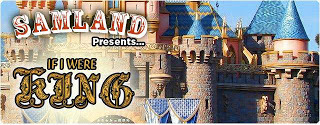
With this column, just for the fun of it I have decided to challenge myself and to ask the question, "If I were king of the North American Disney theme parks and I could do just about anything I wanted. I didn't have to worry about politics or budgets. I just have to do the right thing as I see it. What would I do?"
This column is my response. I challenge to you with the same question. What would you do?
Let's start with the Mothership – Disneyland.
READ THE REST AT MICECHAT
Published on January 26, 2012 05:00
January 24, 2012
WALT DISNEY FAMILY MUSEUM EVENT SNAPSHOTS
On Saturday, January 21, I had the great privilege of hosting a conversation about the proposed Mineral King ski resort with Ron Miller, former CEO of Walt Disney Productions and one of the founders of the Walt Disney Family Museum, and David Price, son of the legendary Buzz Price and an outstanding architect in his own right. I will have a more complete wrap up soon but I wanted to share some photos.
All photos are courtesy of Joseph Titizian
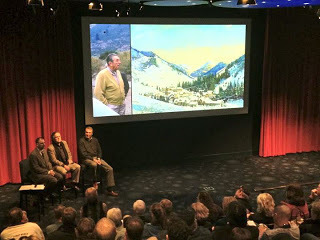
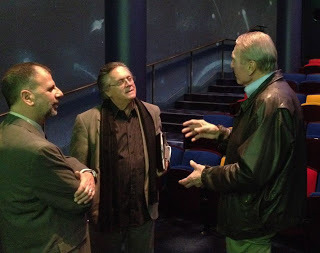 (l to r) Sam Gennawey, David Price, Ron Miller
(l to r) Sam Gennawey, David Price, Ron Miller
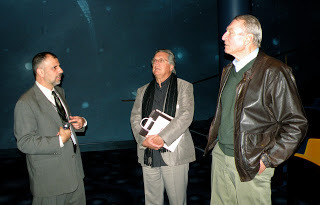
The following photos are courtesy of Frank Teurlay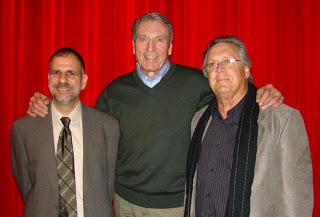
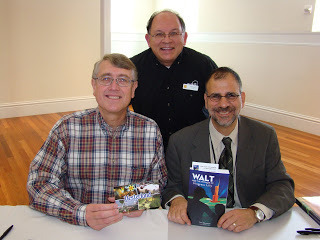 (l to r) Werner Weiss, Frank Teurlay, Sam Gennawey
(l to r) Werner Weiss, Frank Teurlay, Sam Gennawey
Prior to the event was a book signing in the conference hall. Museum members got a chance to chat with Disney historian Jeff Kurtti, Yesterland Curator Werner Weiss, and myself. Joining us were authors Pam Burns-Clair and Don Peri.
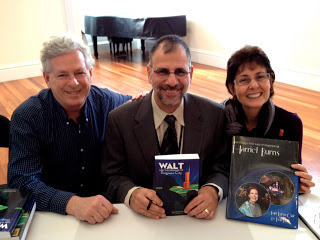

All photos are courtesy of Joseph Titizian

 (l to r) Sam Gennawey, David Price, Ron Miller
(l to r) Sam Gennawey, David Price, Ron Miller

The following photos are courtesy of Frank Teurlay

 (l to r) Werner Weiss, Frank Teurlay, Sam Gennawey
(l to r) Werner Weiss, Frank Teurlay, Sam GennaweyPrior to the event was a book signing in the conference hall. Museum members got a chance to chat with Disney historian Jeff Kurtti, Yesterland Curator Werner Weiss, and myself. Joining us were authors Pam Burns-Clair and Don Peri.

Published on January 24, 2012 15:05
THE WALT DISNEY FAMILY MUSEUM INTERIOR
One of the great things about The Walt Disney Family Museum is you are not bothered by people constantly taking flash pictures while you are trying to enjoy the various exhibits. However, one of the frustrating things is the inability to take photos of the beautiful interior. There is nothing quite like visiting the place and I strongly urge you to do so. If you cannot make it, you can order a splendid book online at waltdisney.org that will give you a sense of the place. So here I present, courtesy of the fine folks at the Museum, a selection of interior shots.
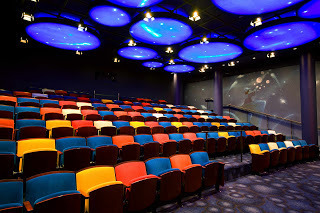
The downstairs theater is an excellent place to take in a vintage movie or to attend one of the talks given at the museum.
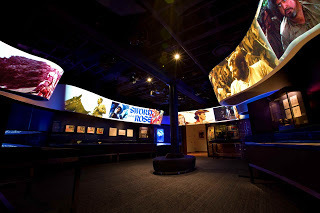
Gallery 7 is a multi-media presentation of Walt post World War II production. You could literally spend hours going through each of the films.
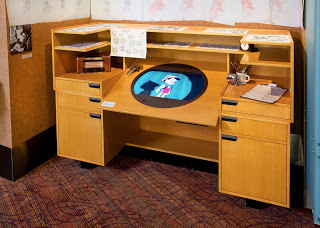
An original animator's desk from the Burbank studio is featured. Imagine what happened at this desk.
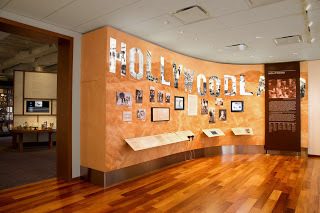
The first gallery on the second floor focuses on Walt's arrival to Hollywood before he makes it to the big time. A very creative period.
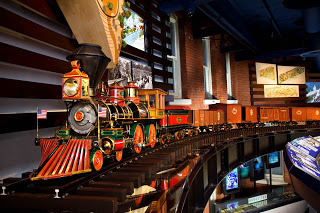
Yes, that is the original, real Lilly Belle locomotive that used to cruise through Walt's backyard.
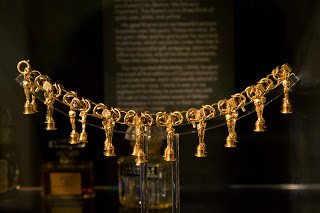
Here is a special Oscar charm bracelet that Walt had made for his wife, Lillian.
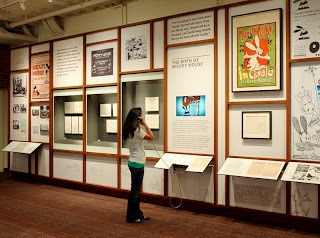
In this gallery we learn about Walt's early success and failure from Oswald the Rabbit. You can also see what must be one of the most important documents in Disney history - the very first drawing of Mickey Mouse.
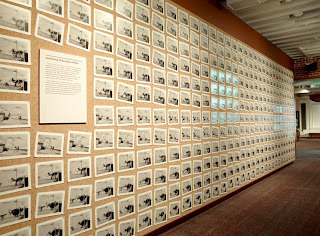
To demonstrate how the animation process works, this wall represents just a few seconds of screen time. Some of the panels come to life to explain the process. You can see just how much work goes into the process.
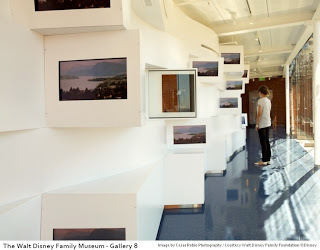 Walt's True-Life Adventures series is highlighted in a corridor at the back of the new addition to the old
Walt's True-Life Adventures series is highlighted in a corridor at the back of the new addition to the old
Army barracks. On one side are TV monitors with scenes from the shows. On the other side is one of the most beautiful views of the Golden Gate Bridge in all of San Francisco.
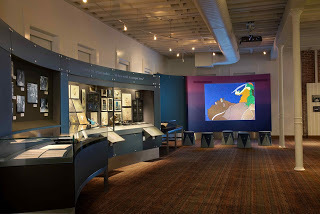
Gallery 5 focuses on the post Snow White feature films. If you are a fan of Fantasia then you will be in heaven.
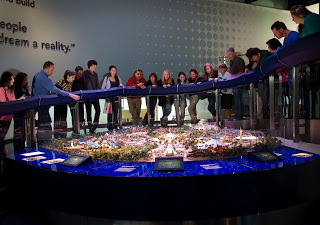
You can get a sense of the scale of the Disneyland that never was and always will be model. A ramp wraps around the model with little TVs embedded showing scenes from the opening day ceremonies.
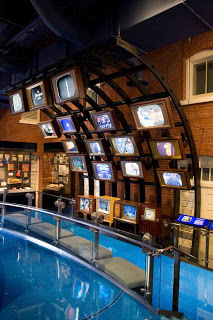
This bank of televisions shows clips of virtually all of the 1950s and 1960s Disney hits. Grab a seat and enjoy the complete loop. The TV array works wonders in presenting a lot of information in a short period of time.
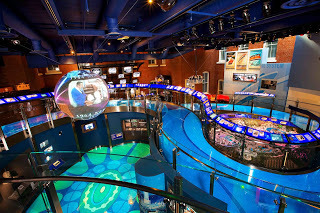
Gallery 9 = Disney Geek Heaven.


The downstairs theater is an excellent place to take in a vintage movie or to attend one of the talks given at the museum.

Gallery 7 is a multi-media presentation of Walt post World War II production. You could literally spend hours going through each of the films.

An original animator's desk from the Burbank studio is featured. Imagine what happened at this desk.

The first gallery on the second floor focuses on Walt's arrival to Hollywood before he makes it to the big time. A very creative period.

Yes, that is the original, real Lilly Belle locomotive that used to cruise through Walt's backyard.

Here is a special Oscar charm bracelet that Walt had made for his wife, Lillian.

In this gallery we learn about Walt's early success and failure from Oswald the Rabbit. You can also see what must be one of the most important documents in Disney history - the very first drawing of Mickey Mouse.

To demonstrate how the animation process works, this wall represents just a few seconds of screen time. Some of the panels come to life to explain the process. You can see just how much work goes into the process.
 Walt's True-Life Adventures series is highlighted in a corridor at the back of the new addition to the old
Walt's True-Life Adventures series is highlighted in a corridor at the back of the new addition to the oldArmy barracks. On one side are TV monitors with scenes from the shows. On the other side is one of the most beautiful views of the Golden Gate Bridge in all of San Francisco.

Gallery 5 focuses on the post Snow White feature films. If you are a fan of Fantasia then you will be in heaven.

You can get a sense of the scale of the Disneyland that never was and always will be model. A ramp wraps around the model with little TVs embedded showing scenes from the opening day ceremonies.

This bank of televisions shows clips of virtually all of the 1950s and 1960s Disney hits. Grab a seat and enjoy the complete loop. The TV array works wonders in presenting a lot of information in a short period of time.

Gallery 9 = Disney Geek Heaven.
Published on January 24, 2012 05:00
January 23, 2012
Panorama: The UK Pavilion
Published on January 23, 2012 01:00
January 19, 2012
Chutes Park
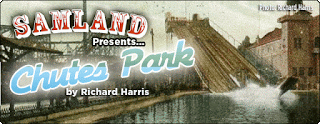
While doing research for Walt and the Promise of Progress City I was struck at the amount of empirical data that Walt and his team collected as part of the creative process. Walt and his team spent a lot of time in the field studying how others did business.
It was not uncommon for Walt to be found hanging out at some of the local amusement parks. He would spend hours observing how the children interacted with the activities.
This week, I would like to revisit one of those great, now lost, Los Angeles theme parks that predated Disneyland. These parks inspired Walt Disney. He knew he could do it better. With the help of noted amusement park historian Richard Harris, this is the story of one such park. We are about to visit Chutes Park.
READ MORE AT MICECHAT
Published on January 19, 2012 01:30

